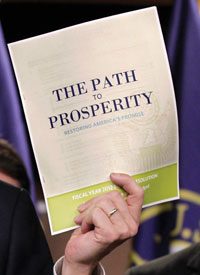
Item:Writing in the New Republic for April 5, Jonathan Chait says that Representative Paul Ryan’s budget plan “is really simple. He cuts Medicare and other vital programs in order to finance a huge tax cut for people who don’t really need it.”
Item:Reporting on a reelection event in Silicon Valley in California, The Hill for April 20 noted that President Obama “strongly criticized House Budget Committee Chairman Paul Ryan’s … proposal to curb entitlement spending, which he characterized as an attack on the Americans most in need. ‘I don’t think it’s particularly courageous,’ Obama said. ‘Nothing is easier than solving a problem on the backs of the people who are poor … and don’t have lobbyists and don’t have clout.’”
Item:The Las Vegas Sun for March 28, in an article entitled “Harry Reid tells Republicans to ‘back off’ Social Security,” quoted the Majority Leader from Nevada saying: “Social Security has not contributed one penny to the debt or the deficit. I believe it’s the most successful program in the history of the world.”
Correction:Even allowing for political hyperbole, Reid’s remarks are off the charts. Still it does show you how far we’ve come in this country. After all, George Washington once said he couldn’t tell a lie, and now look at how many politicians can crank them out, seemingly without effort.
The funding of so-called entitlements is a matter of no small import, especially when the federal budget is swamped with red ink resulting from longstanding irresponsibility by lawmakers. Taken together, the largest programs in this category — Medicare, Medicaid, and Social Security — amount to 40.2 percent of the President’s fiscal 2012 budget. Such entitlement spending is on a projected path to more than double by 2050, with Medicare spending expected to more than triple.
The government, as we write, is approaching the debt limit of $14.3 trillion. But even that astronomical figure does not reflect the true story, considering that, when unfunded liabilities are included, the actual debt is in the neighborhood of $119 trillion. (Liberal Boston University economist Laurence Kotlikoff recently estimated total unfunded obligations at $200 trillion.)
A Cato Institute policy analysis (“Bankrupt: Entitlements and the Federal Budget,” March 28, 2011) summarizes the situation:
We face a debt crisis not because taxes are too low but because government is too big. If there is no change to current policies, by 2050 federal government spending will exceed 42 percent of GDP.
Adding in state and local spending, government at all levels will consume nearly 60 percent of everything produced in this country. Whether financed through debt or taxes, government that large would be a crushing burden to our economy and our liberties.
Driving this massive increase in the size and cost of government are so-called “entitlement programs,” in particular Social Security, Medicare, and Medicaid. Indeed, by 2050, those three programs alone will consume 18.4 percent of GDP. If one assumes that revenues return to and stay at their traditional 18 percent of GDP, then those three programs alone will consume all federal revenues.
The Ponzi scheme known as Social Security, involving inter-generational plundering, has obviously — at least by any rational system of accounting — contributed to budget deficits and national debt. Little wonder why more than two dozen countries have moved, at least in part, toward some form of personal accounts. Even socialist Sweden has partially privatized its version of social security. In this country, the Congressional Budget Office earlier this year could see nothing but red ink each year until the (misleadingly called) trust funds are officially exhausted in 2037. The CBO counts $600 billion in Social Security deficits over the next decade.
Perhaps someone could read that report to Senator Reid. Finance guru Bernie Madoff has the time to do so, considering that his (much less costly) Ponzi scheming, which devastated thousands, earned him 150 years behind bars.
The (hardly right-wing) FactCheck.org also pointed out that Reid’s remarks were simply false, noting that Social Security added $37 billion to the debt last year and another $45 billion this year. The Social Security trustees themselves have reported, as has been noted by Jagadeesh Gokhale in the Washington Times, “that under current payroll tax and benefit rules, the system’s total shortfall equals $16.1 trillion. Of this, the legacy from past and current generations is a debt of $17.4 trillion ($20 trillion worth of gross debt offset by $2.5 trillion of trust fund Treasury securities) and a net projected contribution by future generations of $1.3 trillion.”
Apologists for the Social Security system keep pointing to the “trust fund” as if it contained some real assets to back up the unfunded liabilities of the program. However, even the wastrel Clinton administration knew better. As the Office of Management and Budget (OMB) put it in 2000:
These [trust fund] balances are available to finance future benefit payments and other trust fund expenditures — but only in a bookkeeping sense. These funds are not set up to be pension funds, like the funds of private pension plans. They do not consist of real economic assets that can be drawn down in the future to fund benefits. Instead, they are claims on the Treasury, that, when redeemed, will have to be financed by raising taxes, borrowing from the public, or reducing benefits or other expenditures. The existence of large trust fund balances, therefore, does not, by itself, make it easier for the government to pay benefits.
The plan offered by Congressman Ryan (R-Wis.) is no panacea. It does not deal with Social Security, it calls for overall spending increases from one year to the next over the next decade after a relatively modest drop in fiscal 2012 compared to 2011, and it forecasts deficits of hundreds of billions every year through 2021. But it also proposes cumulative spending cuts of $6.2 trillion for the period 2012-2021 compared to the first budget proposal Obama submitted this year — and not surprisingly this has caused hysterical reactions from the Left.
For instance, the head of the Democratic National Committee, Debbie Wassermann Schultz, blares that Ryan’s plan would “literally be a death trap for seniors.” (Odd, isn’t it, how that overwrought remark could draw almost no play in the press — compared to, say, Sarah Palin’s earlier “death panel” references that caused palpitations among the media?)
Ryan’s enemies also very conveniently ignore what is already barreling toward us under ObamaCare. It will be a surprise, and not a happy one, unless it gets sidetracked. James Capretta, a former OMB associate director and a current fellow at the Ethics and Public Policy Center, fills in the blanks, noting: “Ever since House Republicans introduced their 2012 budget plan, liberals have been howling about the supposed cuts in health care for seniors that would happen under the Ryan Medicare reform. But what they never mention is that Obamacare capped overall Medicare spending.” (Emphasis in original.)
As Capretta stresses in National Reviewfor May 2: “That’s right. Obama-care imposes an upper limit on Medicare spending growth every year, beginning in 2015. This is not yet widely understood among voters, probably because the Obama administration doesn’t want it to be. And, for some Americans (and reporters), maybe it is just too hard to believe that the most liberal Congress in a generation placed a spending cap on one of the Left’s iconic entitlement programs.”
The President’s idea, already contained in his ObamaCare law, is to give 15 unelected political appointees the decision-making power over Medicare. This would, as Representative Ryan correctly notes, permit the “Independent Payment Advisory Board” the ability to “impose price controls and more limitations on providers, which will end up cutting services to seniors.”
The Congressman has been trying to explain his own proposal in the face of the Medicare reaction being thrown out by opponents, who barely stop short of charging him with seeking to euthanize Grandma and Grandpa. Michael Tanner, a senior fellow at Cato, explains otherwise in the New York Post:
Here is what Ryan actually proposes. Everyone who is on Medicare today will be able to stay on the program just as it is. In fact, because Ryan would also repeal the new health care law, seniors in the Medicare Advantage program will actually be able to keep their current plan, whereas ObamaCare would have forced as many as half of them out of their current insurance and back into traditional Medicare. Therefore fewer seniors will lose their insurance under Ryan’s plan than under current law.
Those getting close to retirement will also still go into Medicare, just as they would have before. But beginning in 2022, people who are younger than 55 today will begin to transition to a new system. Instead of going into Medicare at age 65, they will receive a voucher from the U.S. government to help them purchase private health insurance.
In other words, this is not — as Representative Sheila Jackson Lee (D-Texas), among others, likes to put it — a matter of seniors being “thrown off of Medicare.” Tanner continues:
Lower income seniors and those with higher health care costs because of illness will receive a bigger subsidy. Seniors can use these vouchers, combined with whatever they wish to spend of their own money, to choose an insurance plan that has a cost and mix of benefits that best meets their needs….
Ryan recognizes that Medicare cannot simply continue to promise paying for everything for everyone, when it doesn’t have the money to do so. But rather than have the government impose rationing from the top down, he shifts those decisions to individuals.
Ryan’s plan is a far cry from phasing out the federal government’s involvement in healthcare for senior citizens. But it would not, as ObamaCare does, set up a pride of hand-picked presumed experts to decide who shall pay what for healthcare — then try to meet its spending-cap goals by cutting back on the payment rates that will be permitted.
The time for painless solutions is past. According to the Census Bureau, more people in the United States are now getting some kind of federal government support than are paying taxes for the first time since the Great Depression — with an estimated 59 percent receiving at least one federal benefit. During his State of the Union address earlier this year, the President said that Americans had to face the fact that the government is spending more than it takes in.
True. Yet, shortly thereafter, he offered a budget that would add, over the next decade, some $13 trillion to the National Debt. Then he sneeringly questioned Congressman Ryan’s courage. And he continues to push a policy that would give a handful of appointed technocrats the power to play doctor to all of America’s seniors.
So now the President says he stands for reducing the debt and entitlement reform. He’s got his very own plan. Some call it food for thought. Some dare call it baloney.
Photo: AP Images



